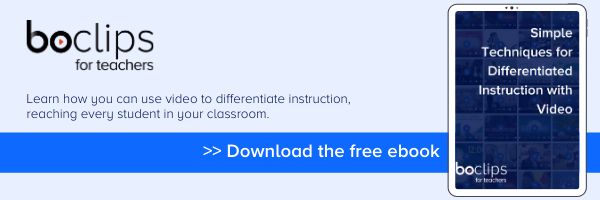Differentiation is at the forefront of every teacher’s mind. Each student is different and needs to be given the opportunity to learn in ways that work for them. Plus, many schools and districts require proof of differentiated instruction. This can seem like a huge task for teachers but it doesn’t have to be.
If a teacher has a good idea of students’ personal interests, learning goals, and strengths, differentiating instruction can be straightforward. With the addition of digital resources, including video, adapting teaching to individual learners’ needs can often be achieved with no additional planning.
In this post, we will share some quick tips for differentiating the learning process with video. Earlier this month, we wrote about how to differentiate learning content: you can find that post here.
<<Want to learn more about how you can amplify great teaching with video? Schedule a demo>>
At the process stage, students have begun to develop a sense of ownership of the content. The teacher’s goal is to provide students with various opportunities to exercise and practice that knowledge with the room to make mistakes, with each mistake furthering their mastery of the material.
1-Have students keep learning journals
Create time for students to explore topics outside of the curriculum and ask them to record their learning in a learning journal. This can be a digital document or a physical notebook where students write summaries of videos, articles, presentations, lectures, or even puzzles that they’ve learned from. Keeping an eye on these journals can help the teacher gain a clearer picture of each student’s individual interests. This process makes an excellent substitute for traditional homework.
2- Partner up students to pair-share their review
After a TED Talk or a news clip, ask students to share their personal response to the material with a peer. Note-taking templates are available on Boclips for Teachers which guide students to identify main ideas and supporting details. These notes can be used by students in their pair-share to support their own opinions and ideas in response to the content.
3- Save time for independent learning with multimedia
Especially before test time, it’s tempting to crunch the prior units into two or three days of study packets in the classroom. Instead, try assigning students individual video or digital resources to practice and review skills they’re still strengthening. LearnZillion and Crash Course are particularly good for this!
We hope that you've found these tips on differentiating the instructional process useful and quick to put into practice. Next month, we'll discuss how to differentiate the learning product with video. Don't want to wait until then? Download our free e-book to discover easy-to-implement tips now.
Bree Fabig
Bree has experience in multicultural and multilingual classrooms in the US, Japan, and Nepal and has taught primary, ESL, SAT prep, and secondary language arts.
- #Classroom
- #Video in Digital Learning
- #Educational Videos
- #Tips for Using Video
- #Video Content Partners
- #Boclips for Publishers
- #Issues in Education
- #Educational Videos by Subject Area
- #News and Announcements
- #Events & Holidays
- #Video and Teaching Tools
- #Teaching Methodologies
- #Education Videos
- #Video and Digital Literacy
- #Short Educational Videos
- #Instructional Design
- #Multimodal Learning
- #Video and Student Safety
- #Accessibility in Education
-3.png?width=390&height=223&name=Untitled%20design%20(2)-3.png)


.png?width=1152&height=660&name=Copy%20of%20Untitled%20Design%20(1).png)
.jpg?width=352&name=group-of-students-learning-in-classroom-P4SLXHR%20(1).jpg)



